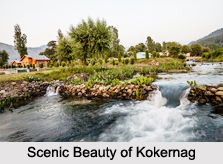 Kokernag is a city and a notified area committee in Breng Valley (The Golden Crown of Kashmir) in Anantnag district in the Indian administered state of Jammu & Kashmir. The name Kokernag is given by Shiekh ul Alam, poet and scholar. He said ""kokernag breng chu sunsund preng" which means that ""kekernag is Golden crown of a Mosque"" means a precious thing. Kokernag is a collection of many small springs and their collective appearance resembles to the claws of a koker (cock). Kokernag is the largest fresh water spring in Kashmir. Koker means `fowl` and nag means `Springs`. The spring gushes out of the base of a thickly wooded hill from where it divides into channels, which resembles to the claw-foot of a hen, hence its name. Kokernag is at the height of approximately 2,000 m above sea level. Place is known for gardens, largest fresh water springs in Kashmir and for its trout streams. Towns and village situated around Kokernag are Wangam, Hangalgund, Nagam, Sagam, Zalergam, Dacksum, Elakti, Soaf Shali breng. It is known for its trout streams and the largest fresh water spring in Kashmir, Trout hatchery department which has constructed pools in series where in trout is reared. The total area of Kokernag is 300 Kanals of which 129 kanals is for the purpose of gardens and the rest is forest area.
Kokernag is a city and a notified area committee in Breng Valley (The Golden Crown of Kashmir) in Anantnag district in the Indian administered state of Jammu & Kashmir. The name Kokernag is given by Shiekh ul Alam, poet and scholar. He said ""kokernag breng chu sunsund preng" which means that ""kekernag is Golden crown of a Mosque"" means a precious thing. Kokernag is a collection of many small springs and their collective appearance resembles to the claws of a koker (cock). Kokernag is the largest fresh water spring in Kashmir. Koker means `fowl` and nag means `Springs`. The spring gushes out of the base of a thickly wooded hill from where it divides into channels, which resembles to the claw-foot of a hen, hence its name. Kokernag is at the height of approximately 2,000 m above sea level. Place is known for gardens, largest fresh water springs in Kashmir and for its trout streams. Towns and village situated around Kokernag are Wangam, Hangalgund, Nagam, Sagam, Zalergam, Dacksum, Elakti, Soaf Shali breng. It is known for its trout streams and the largest fresh water spring in Kashmir, Trout hatchery department which has constructed pools in series where in trout is reared. The total area of Kokernag is 300 Kanals of which 129 kanals is for the purpose of gardens and the rest is forest area.
Naming of Kokernag
The etymology of the word "Kokernag" is controversial and there are various theories and none has any conclusive historical proof. As per one such theory Koker means `fowl` and nag means `serpent`. The spring gushes out of the base of a thickly wooded hill from where it divides into channels, which resembles to the claw-foot of a hen, hence its name. The other theory is that the word Kokernag originates from Koh (Mountain) kan (from or under) nag (spring). The name Kokernag has been derived from the two words namely, koker and nag. Koker has been taken from a Kashmiri word for chicken, while nag has been taken from Sanskrit word for springs.
Location of Kokernag
Kokernag is at the height of approx. 2,000 m above sea level. Kokernag is the place known for gardens, largest fresh water springs in Jammu and Kashmir and for its largest rainbow trout hatchery in northern part of India. Kokernag is situated in the Anantnag District, whose name means abundant springs.
Tourism in Kokernag
Kokernag has a number of towns and villages. Some of the towns and villages situated around Kokernag are Bindoo, Zalangam, Bidder, Wangam, Hangalgund, Nagam, Sagam, Duksum, Soaf Shali etc. Kokernag has been mentioned in Ain-i-Akbari, wherein it has been mentioned that the water of Kokernag satisfies both hunger and thirst and it is also a remedy for indigestion.
Demography of Kokernag
Kokernag had a population of 4,548. Males constitute 68% of the population and females 32%. Kokernag has an average literacy rate of 63%, higher than the national average of 59.5%. Male literacy is 77% and female literacy is 33%. In Kokernag, 9% of the population is aged under 6 years.
Related Articles
Cities of Jammu and Kashmir
Culture of Jammu and Kashmir
Costumes of Jammu and Kashmir
Temples of Jammu and Kashmir
Kashmir, India



















